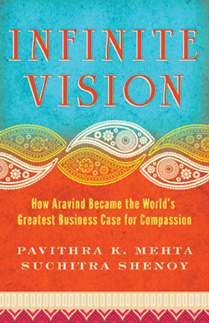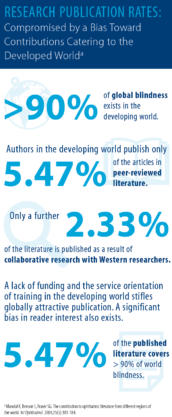


A misapprehension may exist among physicians that limitations in financial resources in low- to middle-income countries necessitate a poorer quality of medical practice or training.1 Although this perspective may not be voiced publicly, it is exchanged in private conversations and is evident, for example, in the choice of attendance to conference presentations by delegates and in the subject matter presented.
AT A GLANCE
• In some countries, trainees often complete their residency programs without having performed a single small-incision extracapsular cataract extraction (SICS) because phaco surgery is held as an unchallenged gold standard.
• Accepting the fallacy that phacoemulsification is superior to SICS and that divide-and-conquer is the only and best technique for cataract surgery can preclude appropriate, individualized perioperative decision making.
An African colleague, experienced in practice in both high- and low-income countries, faced such a perspective when inquiring about employment in a public hospital setting in Australia (oral communication, July 2016). “You wouldn’t be practicing your African ophthalmology here,” a senior colleague warned. Our colleague was speechless as he had been trained in the land of Baerveldt and Molteno, innovators of glaucoma drainage devices; the land of Stegmann, with his pioneering use of viscoelastics and viscocanalostomy; the land of Epstein, with the first hydrophilic acrylic IOLs; and of Amoils, with his innovation in lens cryoextraction. The irony of the senior colleague’s comment was not lost on him. Here he stood, confronted by a respected colleague who seemed unaware that his continent benefited from this belittled African training in the form of three heads of glaucoma departments, among many other respected colleagues.
ABSENT OR INFERIOR
The example of cataract surgery demonstrates this point most effectively. A fight for sight is being waged in the developing world, where more than 90% of global blindness exists.2 Innovative global ophthalmic pioneers in cataract surgery such as Ruit,3 Gogate,4 and Blumenthal5 have led the specialty in taking high-quality, dignified, low-cost, and appropriate services to communities in need.

The inspiring story of the Aravind Eye Hospitals, told in the book Infinite Vision: How Aravind Became the World’s Greatest Business Case for Compassion, describes how 12 million blind patients earning less than $2 per day underwent cataract surgery in this world-class system.6 With less than 1% of the cost of a National Health Service ophthalmology unit in the United Kingdom, but with similar and often lower complication rates than those published by the Royal College of Surgeons,7 this developing-world model has great relevance to the design of efficient and effective global public health care.
Small-incision extracapsular cataract surgery (SICS), the predominant technique used at Aravind hospitals and probably the most widely performed and cost-effective operation globally, was recently featured in an article in The New York Times.8 Numerous articles in the ophthalmic literature, including three recently demonstrating its utility in developed contexts,9-11 have established the equivalence or superiority of SICS compared with phaco cataract surgery.12-14 The need to convert to extracapsular cataract extraction at appropriate times of complicated phaco surgery also necessitates that surgeons acquire this technique.15 Otherwise, cataract blindness is merely converted to refractive blindness when the enlarged Graefe knife-sized limbal-corneal incisions are sutured.
Significant numbers of dense cataracts are often treated suboptimally by phacoemulsification in well-resourced contexts. Trainees frequently complete their residency programs without having performed a single SICS, because phaco surgery is held as an unchallenged gold standard. A survey of US residents put the number who do not acquire the SICS technique at 74%.16
Surely, one cannot legitimately call oneself an adequate cataract surgeon when comfortable only in a single modern technique? High-cost, technologically cutting-edge techniques performed through microincisions are not always best when they expose patients to high cumulative dispersed energy or extended effective phaco time. Increases in these figures are associated with increased risk of serious sight-threatening complications.17,18
Even in prestigious units, old-fashioned extracapsular cataract extraction may still be employed to manage phaco complications despite the well-documented superiority of modern SICS. Trainees in middle- and low-income countries complete their residencies equally adept in both phacoemulsification and SICS, and as a result, they feel confident in any context. In this way, they do not feel overwhelmed when employed or volunteering in the more than 90% of the world that bears the predominant burden of blindness.19
On the Academic Global Ophthalmology Tumblr blog, Alessandra K. Intili, MD, now practicing in the United States, wrote about her residency training in India as part of the Wills Eye Center for Academic Global Ophthalmology: “I am asked by Indian surgeons why an American has come to learn SICS (in India), when high-end phacoemulsification machines are readily available. My answer to that is simple: because we need it.”20
VARIANCE IN SURGICAL TRAINING VOLUME
The numbers of cataract surgeries performed by trainees are generally significantly higher in South Africa, Malawi, and India than in developed countries, while the quality of supervision, didactic teaching, and guidance remains equivalent or, at worst, is more variable. Although surgical volume is by no means the most valuable marker for adequate training, case volume is important in providing exposure and ensuring competence in managing rare conditions and acquiring skills in managing complications such as posterior capsular rupture.19

In some training systems in the developed world, 60% of trainees have never sutured a ruptured globe.20 African trainees suture as many as five a week while on call, at a high level of proficiency, often without onsite supervision. This percentage of trainees lacking experience with globe rupture may indicate an absence of exposure to complicated cases; a highly supervised, litigious milieu; or a reliance on simulated training. Based on a survey of trainees in the Royal College of Surgery, Turnbull and Lash concluded that the level of training mandated in that system was inadequate to provide sufficient experience with complications management to support independent surgical practice.21
The average number of cataract surgeries per trainee per year in the United Kingdom’s 7-year training program ranges between 700 and 900,22 and some US programs require fewer than 120 (86 minimum per regulation) in their entire 3-year program.16 Most African and Indian trainees perform more than 300 cataract surgeries per year, depending on the unit with which they are affiliated. In a residency program in Cape Town, South Africa, it would be unusual for a trainee to complete his or her training with fewer than 1,200 cases, and some individuals perform several thousand. If a small percentage of such cases were complicated by, for example, significant comorbid zonulopathy, the trainee would be skilled and comfortable in its management by the end of training.
SICS: A COMPLEMENTARY COGNITIVE ARTIFACT
In contemporary philosophy, a distinction is made between complementary and competitive cognitive artifacts. Rather than get too deep into the distinction, let it suffice to say that a reliance on a technology that is a competitive cognitive artifact may compromise our ability to function without it.23
For example, if we accept the fallacies that phacoemulsification is superior to SICS and that divide-and-conquer is the only and best technique for cataract surgery, this precludes appropriate, individualized perioperative decision making. The presence of a phaco machine is a competitive cognitive artifact, which creates in the trainee’s mind a reduced ability to act in the best interest of the patient. If the wrong modality is chosen for a given situation, blinding and expensive complications can ensue, which may compromise a patient’s vision, even in a well-resourced training hospital.
There may also be an indirect or diffusive beneficial effect on other skill sets in a setting in which SICS is performed. The practice of fashioning scleral tunnels in SICS may seamlessly be applied to trabeculectomy. Similarly, IOL explantation may be achieved safely and astigmatically without hazardous intraocular gymnastics through the use of microincisions, rather than the alternative astigmatism-inducing large clear corneal incision requiring multiple sutures.24
Viewed in this context, learning and practicing a manual procedure such as SICS is a complementary cognitive artifact that helps the surgeon to maintain surgical skill, broadens the range of surgical options, and may be transferrable to other skills as needed in similar settings.
1. Das J. The quality of medical care in low-income countries: from providers to markets. PLoS Med. 2011;8(4):e1000432.
2. Mandal K, Benson S, Fraser SG. The contribution to ophthalmic literature from different regions of the world. Int Ophthalmol. 2004;25(3):181-184.
3. Kongsan P. Visual outcome of manual small-incision cataract surgery: comparison of modified Blumenthal and Ruit techniques. Int J Ophthalmol. 2011;4(1):62-65.
4. Ruit S, Paudyal G, Gurung R, et al. An innovation in developing world cataract surgery: sutureless extracapsular cataract extraction with intraocular lens implantation. Clin Exp Ophthalmol. 2000;28(4):274-279.
5. Jaggernath J, Gogate P, Moodley V, Naidoo KS. Comparison of cataract surgery techniques: safety, efficacy, and cost-effectiveness. Eur J Ophthalmol. 2014;24(4):520-526.
6. Mehta PK, Shenoy S. Infinite Vision: How Aravind Became the World’s Greatest Business Case for Compassion. Noida, India: Harper Collins India; 2013.
7. Ezra DG, Chandra A, Okhravi N, et al. Higher surgical training in ophthalmology: trends in cumulative surgical experience 1993-2008. Eye (Lond). 2010;24(9):1466-1473.
8. R osenberg T. A hospital network with a vision. The New York Times. January 16, 2013. http://bit.ly/RosenbergT. Accessed June 1, 2017.
9. Cook C, Carrara H, Myer L. Phacoemulsification versus manual small-incision cataract surgery in South Africa. S Afr Med J. 2
10. van Zyl L, Kahawita S, Goggin M. Manual small incision extracapsular cataract surgery in Australia. Clin Exp Ophthalmol. 2014;42(8):729-733. 11. Ang M, Evans JR, Mehta JS. Manual small incision cataract surgery (MSICS) with posterior chamber intraocular lens versus extracapsular cataract extraction (ECCE) with posterior chamber intraocular lens for age-related cataract. Cochrane Database Syst Rev. 2014;(11):CD008811. 12. Venkatesh R, Muralikrishnan R, Balent LC, et al Outcomes of high volume cataract surgeries in a developing country. Br J Ophthalmol. 2005;89(9):1079-1083. 13. Ruit S, Tabin G, Chang D, et al. A prospective randomized clinical trial of phacoemulsification vs. manual sutureless small incision extracapsular cataract surgery in Nepal. Am J Ophthalmol. 2007;143:32-38. 14. Gogate P, Ambardekar P, Kulkarni S, et al. Comparison of endothelial cell loss after cataract surgery: phacoemulsification versus manual small-incision cataract surgery: six-week results of a randomized control trial. J Cataract Refract Surg. 2010;36:247-253. 15. Dada T, Sharma N, Vajpayee RB, Dada VK. Conversion from phacoemulsification to extracapsular cataract extraction: incidence, risk factors, and visual outcome. J Cataract Refract Surg. 1998;24(11):1521-1524. 16. Rowden A, Krishna R. Resident cataract surgical training in United States residency programs. J Cataract Refract Surg. 2002;28(12):2202-2205. 17. George R, Rapauliha P, Sripriya AV, et al. Comparision of endothelial cell loss and surgically induced astigmatism following conventional extracapsular cataract surgery, manual small incision surgery and phacoemulsification. Ophthalmic Epidemiol. 2005;12(5):293-297. 18. Quillen DA, Phipps SJ. Visual outcomes and incidence of vitreous loss for residents performing phacoemulsification without prior planned extracapsular cataract extraction experience. Am J Ophthalmol. 2003;13:5732-5733. 19. Spencer M, McLendon B. Cataract surgery technique in non-industrialized countries — appropriate technology. In: Lewallen S, ed. Before You Go: Information for Ophthalmologists Volunteering in Developing Countries. San Francisco: American Academy of Ophthalmology; 2007. 20. Academic Global Ophthalmology: An Eye Doctor’s Odyssey. http://academicglobalophthalmology.tumblr.com/post/132952407191/in-5-minutes-he-lets-the-blind-see. Accessed March 22, 2017. 21. Turnbull AM, Lash SC. Confidence of ophthalmology specialist trainees in the management of posterior capsule rupture and vitreous loss. Eye (Lond). 2016;30(7):943-948. 22. Rodrigues IA, Symes RJ, Turner S, et al. Ophthalmic surgical training following modernising medical careers: regional variation in experience across the UK. BMJ Open. 2013;3(5). 23. Danaher J. Competitive cognitive artifacts and the demise of humanity: a philosophical analysis. September 18, 2016. Philisophical Disquisitions. http://philosophicaldisquisitions.blogspot.com/2016/09/competitive-cognitive-artifacts-and.html. Accessed March 21, 2017. 24. van Zyl L, Farmer L, Goggin M, Rogers G. Scleral tunnel intraocular lens explantation. Clin Exp Ophthalmol. 2015;43(7):683-684.




